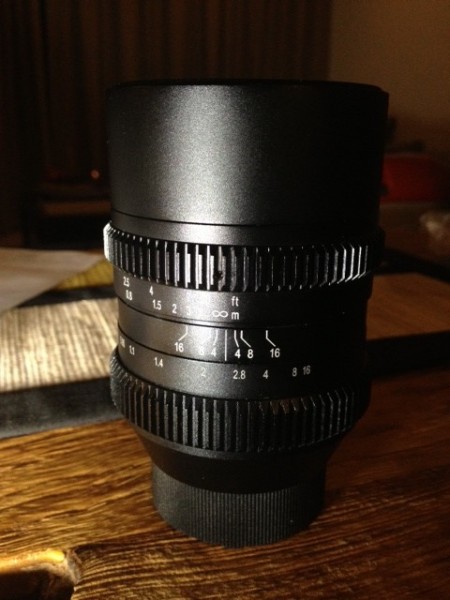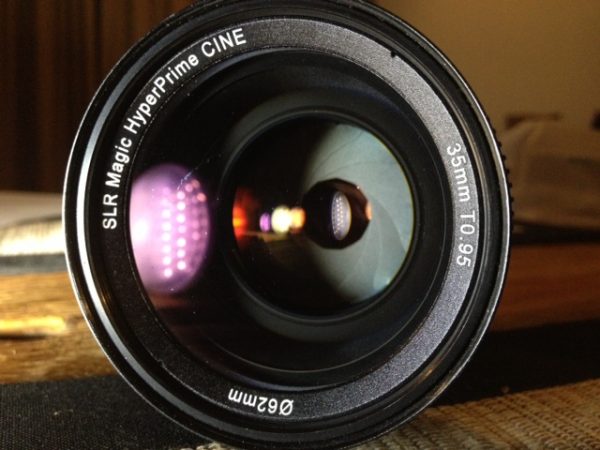By technical editor Matt Allard:
SLR MAGIC 35mm T0.95 Review from Matthew Allard on Vimeo.
Over the last three weeks I have been trying out one of SLR Magic’s new HyperPrime lenses – the 35mm T0.95 – on assignments in Thailand, Japan and Cambodia.
I own their 50mm T.0.95 Leica M mount lens and it is one of my favourites despite its quirks. I was very interested to see how the 35mm (also Leica M mount) compared, though the 50mm is much more expensive: $3000 US compared to $1495 US for the 35mm.
Apart from focal length, the major difference is that the 35mm won’t fit on a native Leica M mount stills camera like the M9 – even though both are Leica M mount. Confused? I know this sounds strange, but there is logic behind this. SLR Magic believe that the Leica M mount is a good mount for adapting to other camera systems and particularly mirrorless cameras. This lens can be used on Sony E-Mount, Micro 4/3 or Fuji X-mount. When you purchase the lens you can specify what camera system you are plan to use and SLR Magic will send you the appropriate adaptor with the lens.
I used this lens on the Sony NEX FS-700, Sony NEX-5 and the Sony PMW-F3. The lens works perfectly on the first two cameras and works on my Sony F3 with limitations. On the F3 the lens with my adapter will not focus to infinity but it is pretty close. This is due to the slightly deeper flange mount on the F3 compared to the E mount that is on the FS700. The lens wasn’t really developed to be used on a camera like the F3 but it still works well for the type of shots you are likely to use with a fast 35mm lens.
The second difference is that the 35mm is not a full-frame lens like the 50mm. It will only cover up to APS-C / Super35 sized sensors. I see this lens being very popular for the Sony FS100/700 and also the M4/3 version of the BMCC. Given the smaller sensor size of the BMCC, the added speed of a T0.95 lens should help achieve a nice shallow DOF.

The lens is metal and very solidly constructed, weighing in at just over 760 grams. It comes with a built-in sun hood and a metal front cap, which I did find a bit of a pain to take on and off. The lens also comes with de-clicked aperture as standard as well as cine gears. I found the focus to be a little loose on the version I was testing and the aperture a little stiff. Despite this the lens is quite easy to use. It also has very little breathing which is impressive for a lens in this price range. The lens has very close focusing which I found to be very useful. It focuses up to a distance of 23cm, which makes it very nice for getting close up shots with a lot of shallow DOF in the background.
The lens features 11 aperture blades which help create a very circular bokeh. The bokeh needs to look nice because you will see a lot of it when the lens is wide open. I quite like the look of the out of focus areas and the highlight fall-off when using this lens. It has a very soft, almost dreamy look to it. Don’t confuse this with the lens being soft – even wide open at T0.95 it is incredibly sharp.
With sharp lenses there is often a compromise. Wide open, they tend to suffer from a lot of chromatic aberration. SLR Magic has done a lot of development with this one to minimise chromatic aberration. It is still there, particularly on certain colours, but is remarkably well controlled. On the FS700 and F3 I found the amount to be more than acceptable. When taking stills photographs wide open on a NEX-5 at night I found a lot of chromatic aberration. I put this down to the NEX-5’s (original version) sensor. I have seen examples with the lens shot on other cameras and it is not nearly as prevalent.
How did I find it for video use? Easy to use and very sharp. When you get the focus perfect the results are very rewarding. It is, however, easy to get it slightly out of focus when the aperture is wide open, so be aware of getting your focus spot on. I tried the camera in a variety of lighting situations to see how much detail it could caper true and also to see how it dealt with flare both during the day and night. How flare looks is very subjective. I found it quite nice during the day, but in certain situations you will get a lot of it. The lens seems to respond well to streams of sunlight and not so much to full sun. If you watch my test shots clip you can judge for yourself. At night you will get a lot of colour bounce in your shots and direct light from, say, a car’s headlights straight down the barrel of the lens will produce massive blooming of the image. If the light is more on a 45 degree it is quite pleasing to the eye. The flare and bokeh can produce quite a nice result. Orange and green colours seem to produce more chromatic aberration than others. Again, check out my test shots for yourself.
Where this lens does excel is of course in low light situations. In Japan I was able to go out at night and shoot at 800 ISO with very little available light. It can really make certain night scenes look like daylight. It offers up lots of possibilities when shooting in dark locations as you can get shots that were previously not possible when using slower lenses. There are lots of times when lenses with fast apertures have saved my bacon. In news and documentary shooting you don’t always get a lot of set up time and situations and shots can be lost just because it was simply too dark for a regular lens.

I think this lens is great for what it does in terms of performance for price. Now, $1495US is not cheap and the lens can’t be used on full frame, or on Canon or Nikon DSLR cameras. But that is not its intended purpose. It is definitely a niche lens but I personally like niche lenses. I only wish SLR Magic would make a complete set of HyperPrimes instead of a limited selection. I think more people would buy them if, say, a matched set of 18mm, 24mm, 35mm, 50mm and 85mm were available. The look of the lens is quite unique and it does cut in quite well with Zeiss glass, though not so much with Canon and Nikon lenses.

It would also work well when capturing high frame rates using the FS700. The added speed would greatly help in combating the loss of light you get when shooting high frame rates. Just be aware that if it’s not in focus high speed looks even worse than in real time!
Over all, I’m impressed with the performance and think it is definitely worth considering as an addition to your arsenal if you’re using a FS100/700 or have ordered a BMCC, or even a Panasonic GH-3. It may not match the rest of your lenses and it will not cover full frame, but it is a staggering fast T0.95 lens that is very sharp and is built to a high standard.
For more information check out their website www.slrmagic.com.
About Matthew Allard, Aljazeera Team Leader Cameras, Kuala Lumpur:
Matt has been a Camera/Editor in TV news for more 22 years, previously working for both Channel 9 and Channel 10 in Australia. Twice Network Ten Australia’s cameraman of the year as well as being a Walkley Finalist for outstanding camerawork in 2006 (for coverage of the Cronulla Race Riots) and a Logie Finalist for outstanding news coverage 2006 (Bali 9). He has won 14 ACS (Australian Cinematographers Society) awards. His Sword Maker story that was shot on a 7D won the prestigious Neil Davis International News Golden Tripod at the 2011 ACS Awards. He has covered news events in more than 35 countries, from major sporting events to terrorist bombings. Based out of the Kuala Lumpur broadcast centre in Malaysia he is an avid user and follower of new technology, shooting stories on HD broadcast cameras, the Sony FS700 and F3 as well as Canon DSLRs.






